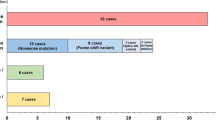Abstract
The p53 gene is known as an anti-oncogene that manifests its function by controlling the cell cycle and is responsible for apoptosis of cells with unrepaired DNA. An accelerated p53 protein synthesis is the first response of a cell following DNA damage. However, mutations of the p53 gene can disturb protein synthesis or may be responsible for synthesis of a changed protein unable to control the cell cycle. Laryngeal tissue specimens from 120 patients were tested by immunohistopathological staining to detect mutated wild-type p53 protein. It was found that p53-positive specimens correlated with TNM staging and histopathological grading. Another indication of entering the cell cycle and undertaking an active proliferation by laryngeal cells was shown by detection of proliferating cell nuclear antigen (PCNA) and Ki67 nuclear antigen, which appeared in proliferating cells (late G1, S-G2 and M phase), but was absent in resting cells. Scoring of the staining for p53 protein, PCNA and Ki67 correlated with each other. DNA from 40 specimens was then isolated, amplified by polymerase chain reaction and analysed by single-strand conformation polymorphism and DNA sequencing for mutation in the p53 gene. Fifteen DNA samples were found to be positive, while mutations were detected in exons 5–8 in 13 samples. The majority of mutations were found in tissue specimens from T3 and T4 tumors. A possible explanation is almost half was attributable to genotoxic effects of tobacco smoking. Changes in the p53 gene and its products may also reflect early changes in laryngeal carcinogenesis and be of prognostic value.
Similar content being viewed by others
References
Anwar K, Nakakuki K, Imai H, Naiki H, Inzuzuka M (1993) Overexpression of p53 protein in human laryngeal carcinoma. Int J Cancer 53: 952–956
Biggs P, Warren W, Venitt S, Stratton MR (1993) Does a genotoxic carcinogen contribute to human breast cancer? The value of mutational spectra in unravelling the aetiology of cancer. Mutagenesis 8: 275–283
Boag G, Lee CS, Charalambous D, Rode J (1993) p53 expression in laryngeal carcinoma. Pathology 25: 394–397
Brachman DG, Beckett M, Graves D, Haraf D, Vokes E, Weichselbaum RR (1993) p53 mutation does not correlate with radiosensitivity in 24 head and neck cancer cell lines. Cancer Res 53:3667–3669
Chang F, Syrjanen S, Syrjanen K (1995) Implications of the p53 tumor-suppressor gene in clinical oncology. J Clin Oncol 13:1009–1014
Chung KY, Mukhopadhyay T, Kim J, Casson A, Ro JY, Goepfert H, Hong WK, Roth JA (1993) Discordant p53 gene mutations in primary head and neck cancers and corresponding second primary cancers of the upper aerodigestive tract. Cancer Res 53: 1676–1683
Dolcetti R, Doglinii C, Maestro R, Gasparotto D, Barzan L, Pastore A, Romanelli M, Boiocchi M (1992) p53 over-expression is an early event in the development of human squamous-cell carcinoma of the larynx: genetic and prognostic implications. Int J Cancer 52: 178–182
Field JK, Pavelic ZP, Spandidos DA, Stambrook PJ, Jones AS, Gluckman JL (1993) The role of the p53 tumour suppressor gene in squamous cell carcinoma of the head and neck. Arch Otolaryngol Head Neck Surg 119: 1118–1122
Gluckman JL, Stambrook PJ, Pavelic ZP (1994) Prognostic significance of p53 protein accumulation in early stage T1 oral cavity cancer (letter). Oral Oncol Eur J Cancer 4: 281–282
Knudsen AG (1991) Genes that predispose to cancer. Mutat Res 247: 184–190
Lee NK, Ye Y-W, Chen J, Li X., Waber PG, Nisen PD (1993) p53, retinoblastoma and human papillomavirus in squamous cell carcinom and adjacent normal mucosa of the aerodigestive tract. Arch Otolaryngol Head Neck Surg 119: 1125–1131
Maestro R, Dolcetti R, Gasparotto D, Doglioni C, Pelucchi S, Barzan L, Grandi E, Boicchi M (1992) High frequency of p53 gene alteration associated with protein overexpression in human squamous cell carcinoma of the larynx. Oncogene 7: 1159–1160
Munck-Wikland E, Edstrom S, Jungmark E, Kuylenstierna R, Lindholm J, Auer G (1994) Nuclear DNA content, proliferating-cell nuclear antigen (PCNA) and p53 immunostaining in predicting progresion of laryngeal cancer in situ lesions. Int J Cancer 56: 5–9
Nakanishi Y, Noguchi M, Matsuno Y, Saikawa M, Mukai K, Shimosato Y, Hirohashi S (1995) p53 expression in multicentric squamous cell carcinoma and surrounding squamous epithelium of the upper aerodigestiv tract. Cancer 75: 1657–1662
Nishioka H, Hiasa Y, Hayashi I, Kitahori Y, Konishi N, Sugimura M (1993) Immunohistochemical detection of p53 oncoprotein in human oral squamous cell carcinomas and leukoplakias: comparison with proliferating cell nuclear antigen staining and correlation with clinicopathological indings. Oncology 50: 426–429
Nylander K, Stenling R, Gustafsson H, Zackrisson B, Ross G (1995) p53 expression and cell proliferation in squamous cell carcinomas of the head and neck. Cancer 75: 87–93
Shin DM, Kim J, Ro JY, Hittelman J, Roth JA, Hong WK, Hittelman WN (1994) Activation of p53 gene expression in premalignant lesions during head and neck tumorigenesis. Cancer Res 54: 321–326
Slootweg PJ, Koole R, Hordijk GT (1994) The presence of p53 protein in relation to Ki67 as cellular proliferation marker in head and neck squamous cell carcinoma and adjacent dysplastic mucosa. Oral Oncol Eur J Cancer 30B: 138–141
Somers KD, Merrick MA, Lopez ME, Incognito LS, Schechter GL, Casey G (1992) Frequent p53 mutations in head and neck cancer. Cancer Res 52: 5997–6000
Tomasino RM, Morello V, Bazan V, Nagar C, Tralongo V, Dardanoni G, Ingria F, Monteleone G, Restivo S, Nuara R, Daniele E, Russo A (1994) p53 expression in stage III–IV carcinoma of the larynx: an immunohistochemical study related to clinicopathological, flow-cytometric DNA analysis and prognosis. Int J Oncol 5: 495–500
Zhang LF, Hemminki K, Szyfter K, Szyfter W, Soderkvist P (1994) p53 mutations in larynx cancer. Carcinogenesis 15: 2949–2951
Author information
Authors and Affiliations
Rights and permissions
About this article
Cite this article
Golusinski, W., Olofsson, J., Szmeja, Z. et al. Alteration of p53 gene structure and function in laryngeal squamous cell cancer. Eur Arch Otorhinolaryngol 254 (Suppl 1), S133–S137 (1997). https://doi.org/10.1007/BF02439744
Issue Date:
DOI: https://doi.org/10.1007/BF02439744




